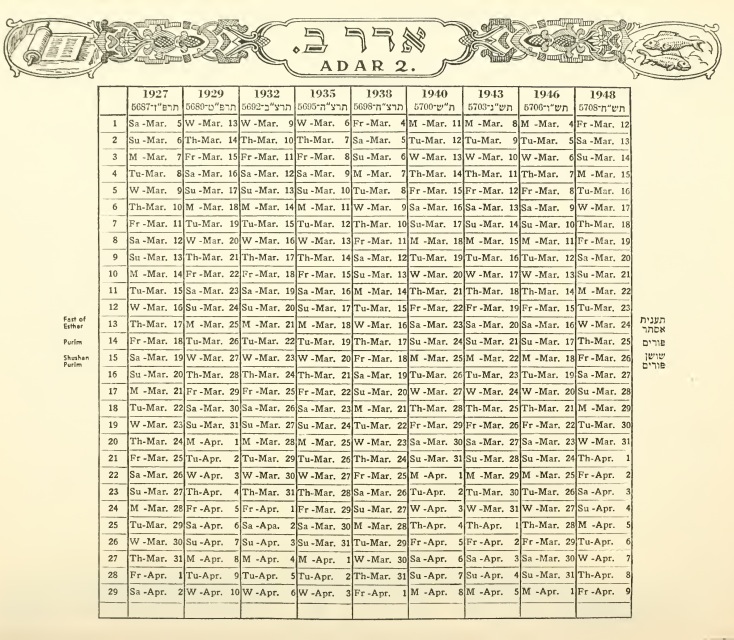Facts for Kids
The Hebrew calendar is a lunisolar system used for Jewish religious observances, consisting of 12 or 13 months depending on the year.
Overview
Modern Usage
Historical Origins
Cultural Significance
Lunar And Solar Influence
Structure Of The Calendar
Celebrations And Traditions
Major Holidays And Festivals
Comparisons With Other Calendars

Inside this Article
Gregorian Calendar
Islamic Calendar
Rosh Hashanah
Jewish People
Babylonian
Yom Kippur
Reflection
New Moon
Calendar
Did you know?
📅 The Hebrew calendar is a lunisolar calendar, meaning it is based on both the moon's phases and the sun's position.
🌙 Each month in the Hebrew calendar begins with the sighting of the new moon.
🕍 The calendar has 12 months in a common year and 13 months in a leap year.
📖 The Hebrew calendar year starts with the month of Tishrei, which usually falls in September or October.
🎉 Rosh Hashanah, the Jewish New Year, occurs in the month of Tishrei.
🔔 Yom Kippur, the Day of Atonement, is observed 10 days after Rosh Hashanah.
🌾 The month of Nissan is when Passover is celebrated, commemorating the Exodus from Egypt.
🍂 The month of Elul is traditionally a time for reflection and preparation for the High Holidays.
🔄 Hebrew calendar months alternate between 29 and 30 days, making the calendar around 354 days long.
✨ A leap year, which adds the month of Adar II, occurs 7 times in a 19-year cycle.
Introduction
️ It is a lunar-solar calendar, meaning it’s based on the moon and the sun. This calendar has 12 months, but sometimes it has an extra month to keep the seasons in check! 🌙
The months are full of fantastic names like Kislev and Adar. The Hebrew year usually starts in the autumn. This calendar helps people celebrate important holidays, figure out when to pray, and remember special dates in Jewish history!
Modern Usage
️ Jewish communities around the world, like in Israel and the United States, celebrate holidays according to the Hebrew calendar. 📍
Schools teach children about it, and families plan special meals and gatherings for Jewish holidays. Some calendars even show both dates, so everyone can stay connected to their traditions while also enjoying modern life! 📚
The calendar continues to be a vital part of Jewish culture, helping people remember where they came from.
Historical Origins
It started as a way for the ancient Hebrews to track time, especially while living in Egypt. 🐫
When they escaped from slavery, they began to follow a calendar system that included months based on the moon cycles. The calendar was settled officially during the Babylonian exile around 586 B.C.E. 📜
Since then, it has been an essential part of Jewish culture, helping people stay connected to their history and traditions!
Cultural Significance
Each month and holiday has its own stories and meanings, teaching children and families about their heritage. 🌳
The calendar forms the rhythm of Jewish life, helping to create a sense of belonging. Many songs, stories, and prayers are linked to these special occasions, making it a beautiful tool for connection across generations!
Lunar And Solar Influence
For example, if spring is arriving too early, an extra month helps keep everything on track. This clever way keeps Hebrew holidays in their proper seasons, making sure celebrations happen at the right time!
Structure Of The Calendar
The months are: Tishrei, Cheshvan, Kislev, Tevet, Shevat, Adar, Nisan, Iyar, Sivan, Tammuz, Av, and Elul. The extra month, called Adar II, is added during leap years, making it 13 months! The calendar starts with Tishrei, when the Jewish New Year, Rosh Hashanah, is celebrated. The Hebrew year is also different from the Gregorian calendar, which most people use today!
Celebrations And Traditions
For Rosh Hashanah, people blow the shofar, a special ram's horn, while eating sweet foods. On Hanukkah, families gather to light candles, spin dreidels, and eat delicious latkes! 🥔
Passover is celebrated with an exciting Seder meal, where families read from the Haggadah. 🥙
During Yom Kippur, people fast and pray for forgiveness. These celebrations help everyone feel close to their family, friends, and history, making them joyful and meaningful moments in life! 🎈
Major Holidays And Festivals
Rosh Hashanah is for reflection and goodies like apples and honey! 🍏🍯 Hanukkah lasts for eight days and involves lighting candles on a menorah. 🕯
️ Passover, commemorating the escape from Egypt, involves eating matzah. These holidays help bring families together to celebrate traditions and remember their history.
Comparisons With Other Calendars
The Gregorian calendar is solar and has 12 months, but each month’s length is fixed. 📅
The Islamic calendar is another lunar calendar, which has 12 months but fewer days in a year compared to the Hebrew calendar. 🕌
This affects when holidays fall each year. The Hebrew calendar also includes extra months during leap years, making it unique! By comparing these calendars, we see how people around the world keep track of time in various ways.

